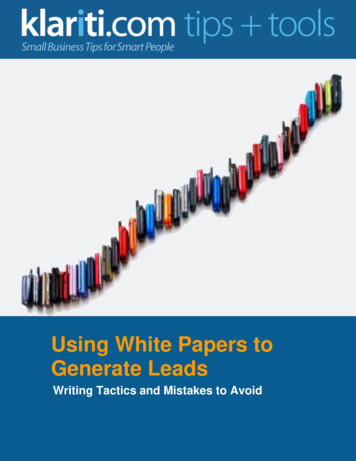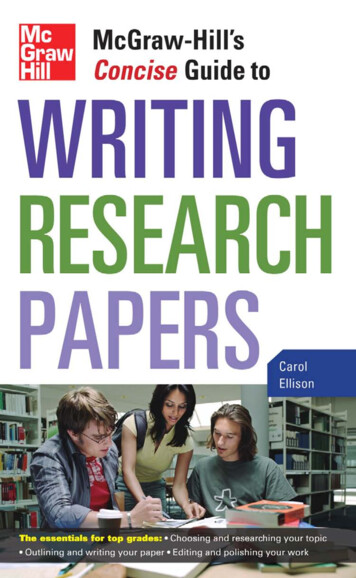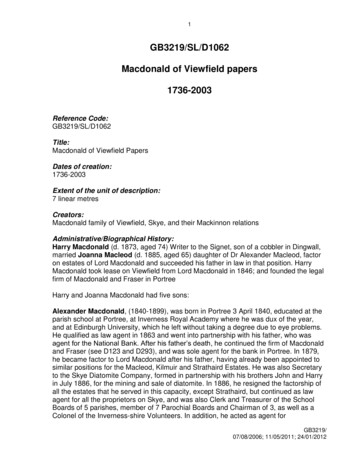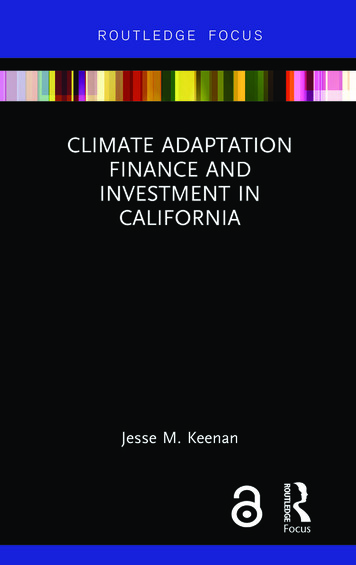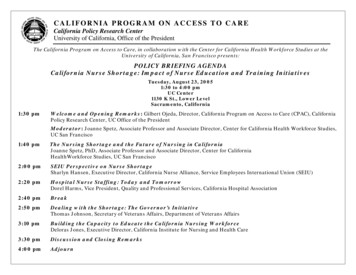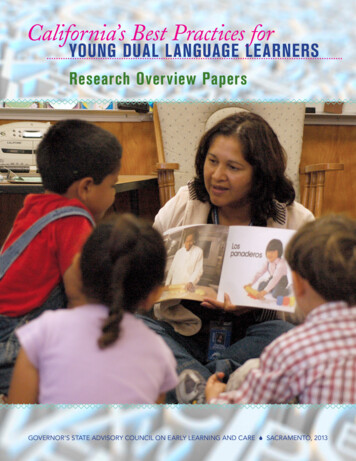
Transcription
California’s Best Practices forYOUNG DUAL LANGUAGE LEARNERSResearch Overview PapersGOVERNOR’S STATE ADVISORY COUNCIL ON EARLY LEARNING AND CARE SACRAMENTO, 2013
California’s Best Practices forYoung Dual Language LearnersResearch Overview PapersGovernor’s State Advisory Council on Early Learning and CareSacramento, 2013
Publishing InformationCalifornia’s Best Practices for Young Dual Language Learners: Research Overview Papers wasprepared under the direction of the Child Development Division, California Department ofEducation (CDE), for the State Advisory Council on Early Learning and Care. This publicationwas edited by Faye Ong and John McLean, working in cooperation with Cecelia Fisher-Dahms,Education Administrator I, Quality Improvement Office, Child Development Division. It wasdesigned and prepared by the staff of CDE Press for online posting, with the cover created byTuyet Truong. The document was published by the Department of Education, 1430 N Street,Sacramento, CA 95814. It was distributed under the provisions of the Library Distribution Actand Government Code Section 11096. 2013 by the State Advisory Council on Early Learning and CareAll rights reservedISBN 978-0-8011-1742-8CDE Publications and Educational ResourcesFor information about publications and educational resources available from the CaliforniaDepartment of Education, visit http://www.cde.ca.gov/re/pn/rc/ or call the CDE Press sales officeat 1-800-995-4099.NoticeThe guidance in California’s Best Practices for Young Dual Language Learners: ResearchOverview Papers is not binding on local educational agencies or other entities. Except for thestatutes, regulations, and court decisions that are referenced herein, the document is exemplary,and compliance with it is not mandatory. (See Education Code Section 33308.5.)ii
ContentsA Message from the State Advisory Council Co-Chairs .Acknowledgments.Paper 1. Neuroscience Research: How Experience with One or More Languages Affects theDeveloping Brain .Barbara ConboyPaper 2. Cognitive Consequences of Dual Language Learning: Cognitive Function, Languageand Literacy, Science and Mathematics, and Social–Emotional Development.Catherine Sandhofer and Yuuko UchikoshiPaper 3. Program Elements and Teaching Practices to Support Young Dual Language Learners .Claude Goldenberg, Karen Nemeth, Judy Hicks, Marlene Zepeda, and Luz Marina CardonaPaper 4. Family Engagement in Early Childhood Programs: Serving Families of Dual LanguageLearners.Linda Halgunseth, Gisela Jia, and Oscar BarbarinPaper 5. Assessment of Young Dual Language Learners in Preschool .Linda Espinosa and Vera Gutiérrez-ClellenPaper 6. Early Intervention and Young Dual Language Learners with Special Needs .Deborah Chen and Vera Gutiérrez-Clelleniii
A Message from the State Advisory Council Co-ChairsWe are pleased to present California’s Best Practices for Young Dual Language Learners:Research Overview Papers, a publication we believe will provide early childhood educators withvaluable information on the most current research on the development of young dual languagelearners. This series of research overviews spans the disciplines of neuroscience, cognitivescience, developmental psychology, assessment, educational research, family engagement, andspecial needs. Insights from the reviews informed the creation of the forthcoming CaliforniaPreschool Program Guidelines, a publication that addresses how to provide high-quality,developmentally and individually appropriate preschool services for young children. In particular,information from the research reviews guided the formulation of best practices for supporting thelearning and development of California’s young dual language learners.The first two research overviews focus on different aspects of dual language development.Paper 1 (“Neuroscience Research: How Experience with One or More Languages Affects theDeveloping Brain”) reviews basic neuroscience and developmental cognitive neuroscienceresearch relevant to language development. The paper discusses the general process of learninglanguage in the early years, whether learning one language or two or more languages. The paperalso addresses differences in how the brain processes language when learning two or morelanguages, and concludes that these differences do not reflect delays or deficits, but rather areadaptations to the unique circumstances of learning two or more languages—which, in turn, canlead to developmental advantages when two or more languages are supported through enrichedlearning opportunities.Paper 2 (“Cognitive Consequences of Dual Language Learning: Cognitive Function,Language and Literacy, Science and Mathematics, and Social–Emotional Development”)summarizes the current research on the cognitive consequences of dual language development.The paper highlights how dual language learning affects general cognitive functioning, includingexecutive control and memory, as well as areas of learning that have a strong cognitivecomponent, such as language and literacy, mathematics, science, and social–emotionaldevelopment.The next two papers focus on the preschool program, addressing programmatic elements,teaching practices, and collaboration with families. Paper 3 (“Program Elements and TeachingPractices to Support Young Dual Language Learners”) summarizes research on programiv
elements and strategies that effectively support the learning and development of young duallanguage learners in preschool. The authors describe the elements of high-quality preschool thatbenefit all children and identify additional practices that specifically enhance the learning anddevelopment of young dual language learners. In particular, the paper discusses the importanceof providing continuing support for children’s home language as they learn English, as homelanguage proficiency is foundational for learning and development across all domains includingEnglish-language development.Paper 4 (“Family Engagement in Early Childhood Programs: Serving Families of DualLanguage Learners”) reviews the many positive developmental child outcomes that areassociated with family engagement. The authors underscore the importance of strengtheningfamily engagement in preschool for children’s future learning and families’ continuedparticipation in educational settings. The paper pays particular attention to how to foster familyengagement with families of young dual language learners. Topics include addressing thebilingual and bicultural needs of families, developing warm and mutually respectful relationships,engaging in regular two-way communication, and approaching families with a strength-basedperspective.The final two papers examine assessment, early intervention, and young dual languagelearners with special needs. Paper 5 (“Assessment of Young Dual Language Learners inPreschool”) focuses on the importance of accurate and valid assessment of young dual languagelearners’ development and achievement. The paper discusses the need to take into accountlinguistic, cultural, and background considerations when assessing young dual language learners.Two specific purposes of assessment are addressed: (1) observational assessment forinstructional decision making and improvement, and (2) assessment for screening and referral ofchildren who may have special needs. The paper also makes clear that assessments must be valid,reliable, and linguistically and culturally appropriate. It closes with guidance for practitioners onassessing young dual language learners, including a flowchart and assessment matrix withspecific questions and suggestions that can guide teachers’ decisions.Paper 6 (“Early Intervention and Young Dual Language Learners with Special Needs”)addresses both the language development of young dual language learners with special needs andkey considerations when choosing the language for intervention. The overview states thatchildren with a range of special needs can learn more than one language. In fact, children withlanguage disorders can apply their home language skills when learning a second language, whichv
in many cases results in a greater rate of learning of the second language. Of particular note, theauthors found that the use of the home language in intervention does not slow the acquisition ofthe second language.As a set, these six research overviews reflect the most current research related to the learningand development of young dual language learners. They provide insight into how young duallanguage learners learn two languages, and also how they learn and develop in other domains. Atthe same time, the research summaries provide guidance to early childhood educators on how tosupport the learning and development of young dual language learners in preschool programs.We hope that these research overviews will be an invaluable resource for supporting the learningand development of young dual language learners in California’s preschool programs.PETE CERVINKALUPITA CORTEZ ALCALÁCo-Chair, State Advisory CouncilCo-Chair, State Advisory CouncilCalifornia Department of Social ServicesCalifornia Department of Educationvi
AcknowledgmentsCalifornia’s Best Practices for Young Dual Language Learners: Research Overview Paperswas developed with the support of the California Department of Education and the leadership ofWestEd project directors Peter Mangione and Ann-Marie Wiese, as well as project managerKatie Monahan, in collaboration with Linda Espinosa, the lead researcher for the project.This research project of the California State Advisory Council on Early Learning and Carewas made possible through American Recovery and Reinvestment Act (ARRA) funds granted toCalifornia under the Improving Head Start for School Readiness Act of 2007, with the CaliforniaDepartment of Education as the lead agency.The following individuals are gratefully acknowledged for their expertise and contributionsto this project:Eugene E. Garcia, Arizona State University (reviewer for Paper 2 and Paper 3)Gisela Jia, Lehman College (contribution to Paper 1)Marlene Zepeda, California State University, Los Angeles (contribution to Paper 2)Advisory Group: California’s Best Practices for Young Dual Language LearnersLinda Espinosa, Co-Principal Investigator, Center for Early Care and Education Research—Dual Language Learners, Frank Porter Graham Child Development Institute, University ofNorth Carolina, Chapel HillOscar Barbarin, Tulane UniversityLuz Marina Cardona, Cabrillo Community CollegeDeborah Chen, California State University, NorthridgeBarbara Conboy, University of RedlandsClaude Goldenberg, Stanford UniversityVera Gutiérrez-Clellen, San Diego State UniversityLinda Halgunseth, University of ConnecticutGisela Jia, Lehman CollegeKaren Nemeth, Language Castle LLCCatherine Sandhofer, University of California, Los AngelesYuuko Uchikoshi, University of California, DavisMarlene Zepeda, California State University, Los Angelesvii
Advisory Group—Field RepresentativesKaren Gonzales, SETA Head StartAntonia Lopez, National Council of La RazaOfelia Medina, Alliance for a Better CommunityCalifornia Department of EducationCamille Maben, Former Director, Child Development DivisionCecelia Fisher-Dahms, Administrator, Child Development DivisionKaren Cadiero-Kaplan, Director, English Learner Support DivisionMeredith Cathcart, Special Education DivisionWestEdPeter Mangione, Project Co-DirectorAnn-Marie Wiese, Project Co-DirectorLaurel Stever, Director of OperationsAmy Schustz, Program AssociateGina Morimoto, Project CoordinatorTeresa Ragsdale, Program AssistantNote: The names, titles, and affiliations of the individuals named in these acknowledgments were current at the timethis publication was developed.viii
Paper 1Neuroscience Research:How Experience with One or More Languages Affects theDeveloping BrainBarbara T. Conboy, PhD, Associate ProfessorDepartment of Communicative DisordersUniversity of Redlands1
Over the past several decades, improvements in technology have increasingly allowedresearchers to address questions regarding human brain and cognitive development. One type ofresearch question concerns whether early experiences alter perception and informationprocessing systems in ways that impact children’s early learning and future outcomes. This paperfocuses on the question of whether growing up with two or more languages, instead of only one,has small effects on brain function and, subsequently, on future language learning. A promise ofdevelopmental cognitive neuroscience research is that it can help inform best practices ineducation. However, a pitfall is that neuroscience research findings are sometimes misinterpretedby the public and by members of the educational community, and such misinterpretations may beused to justify questionable educational practices.The goal of this paper is to review some key findings from basic neuroscience anddevelopmental cognitive neuroscience research that are relevant to the preschool education ofyoung dual language learners (DLLs), and to provide the reader with a conceptual framework forunderstanding those findings. The research reviewed includes a growing body of studies that usemeasures of brain activity, which tap into the organization and functioning of language-relevantneural systems in ways that measures of young children’s behaviors cannot. Together withstudies of children’s behaviors, including performance on tests and other structured tasks, thebrain-imaging studies have led to the following conclusions:1. Language experience affects the organization of the neural systems involved in learning,storing, processing, and producing language (i.e., there is evidence of structural andfunctional differences between the brains of monolingual learners and DLLs).2. Dual language learning and use involve some different cognitive processes than singlelanguage learning and use.3. The effects of language learning experiences on the brain facilitate and constrain furtherlearning, and these experiential effects may be what are often referred to as “criticalperiod” effects in second language acquisition.In addition, this paper will attempt to provide a realistic view of how practitioners andpolicymakers can translate evidence from neuroscience research to best practices in theeducation of young DLLs.2
A Conceptual Framework: Neuroconstructivism and Language LearningThe neuroconstructivist approach to cognitive development (Karmiloff-Smith 2008;Mareschal et al. 2007; Westermann et al. 2007) provides a theoretical framework for thinkingabout relationships between children’s early language experiences (such as dual languagelearning), children’s skills and behaviors in each language, and brain development. In contrastwith frameworks that pose questions regarding the relative roles of “nature” and “nurture” invarious aspects of development, neuroconstructivism assumes that a dynamic interplay betweennature and nurture influences both the structure and the functional organization of the brainthroughout development (for similar approaches, see Diamond 2009; Gottlieb 2007;Johnson 2000). Moreover, neuroconstructivist and related approaches do not assume that thereis a unidirectional causal path from genes, to the maturation (i.e., physical growth) of particularbrain areas, to the use of those brain areas for cognitive behaviors such as language (see Paper 2,Development Across Domains, for more information about the relationship between duallanguage development and cognition). Such approaches do not assume that there is a biologicalclock that determines when the brain will be ready for particular aspects of language learning totake place or when a “critical period” for learning aspects of language ends. Instead, theseframeworks assume that specialized systems for complex cognitive behaviors such as languageemerge as a product of experience, and that there are bidirectional influences between genes,structural brain changes, and cognitive functions. According to this view, humans inherit agenetic blueprint that guides certain aspects of development, but the environment can influencewhich genes are expressed (this process is known as probabilistic epigenesis); geneticinfluences on brain maturation can also influence how much a child can take in, and thus learn,from his or her environment at various points in development; and previous learning caninfluence further learning by changing the brain’s structure and function (Gottlieb 2007). In sum,neuroconstructivism views brain development as being dynamic throughout the life span ratherthan ending after a particular end-state of maturation is reached. Cognition is thought to beconstructed in a progressive manner, with new cognitive abilities based on previous, simplerones. That is, development itself changes the ways that further development occurs (Mareschal etal. 2007).3
This paper will review how the neuroconstructivist framework might be applied to thinkingabout the following dynamic aspects of dual language learning and use that have been noted inthe scientific literature: differences in brain structure and function between bilingual individuals (who controltwo different vocabularies, sets of speech sounds, and systems of grammatical rules) andmonolingual individuals (who control only one language); changes in brain structure and function that occur within individuals as they learn anotherlanguage, or as they become more or less proficient in one of the languages that theyalready know due to increases or decreases in use over time; different patterns of brain activity for processing each of the same individuals’ languages,with which they have different experiences and levels of expertise, even when the twolanguages are acquired in early childhood; the apparent ease of learning a second language during early childhood compared withlater childhood or adulthood (i.e., what is commonly known as “critical period” effects insecond-language acquisition), as well as cases of individuals who reach native-likeproficiency in a language that they begin to learn at later ages.As discussed by Mareschal and others (2007), the goal of neuroconstructivism is not toreduce complex cognitive behaviors or functions to descriptions at the neural level or to mapfunctions to specific regions of the brain. Instead, the goal is to develop models of how aspectsof cognition, such as language, might emerge in a brain that is embodied within a developinghuman, which in turn is embedded in a physical and social environment. Thus, cognitivebehaviors, such as language knowledge and use, are thought to be influenced by externalphysical and social experiences. A central tenet of the neuroconstructivist approach is thatknowledge becomes represented in the brain through the progressive elaboration of corticalstructures. Thus, in order to consider how the neuroconstructivist framework might be applied todual language learning and use, the reader needs to consider some key aspects of early braindevelopment and how they might be influenced by the contexts in which many preschool DLLsdevelop. These are summarized in the next section.4
Key Events in Brain DevelopmentEarly brain development has been characterized as the product of progressive (i.e., additive) andregressive (i.e., eliminative) events that work together to shape the brain and that are essential fornormal development. These events may be predetermined by genetics, may occur spontaneously,or may be influenced by events in the environment (referred to as “experience-dependent”aspects of brain development; for example, see Greenough, Black, and Wallace 2002). Anorganism’s experiences are mediated by neural activity, and this activity influences how someneural structures are added, eliminated, or become active (Mareschal et al. 2007). Examples ofprogressive events in brain development are neurogenesis, synaptogenesis, and myelination;regressive events include programmed cell death and synaptic pruning (see below, for furtherexplanation). Another key event in brain development that may also be explained byneuroconstructivism is the specialization of networks of neurons for particular sensory,perceptual, motor, and cognitive functions (Johnson 2000). Practitioners should be aware of whatis known, as well as what is not known, about how these events relate to particular experiencesof young DLLs, such as the timing and contexts of first- and second-language learning.Practitioners should also be aware of the dynamic nature of brain development throughout thelife span, and its implications for language learning. This section provides a brief overview ofseveral key aspects of development in the cerebral cortex, the outermost layers of the brain mostimportant for language and cognitive functions, and a discussion of the implications for duallanguage learning. (For more comprehensive reviews of the literature on human braindevelopment, see Brown and Jernigan 2012; Clancy and Finlay 2001; Lenroot and Giedd 2006;Sowell, Thompson, and Toga 2004.)During brain development, neurons (nerve cells) are generated in regions called proliferativezones (neurogenesis); then migrate to particular destinations in the brain; differentiate intoparticular subtypes; and project extensions from the cell body called axons (which carry neuralactivity to other neurons by transmitting chemoelectrical signals), and branch-like dendrites(which receive activity from other axons). The gap where the axon of one neuron forms aconnection with either the dendrite or cell body of another neuron (and where the firing of oneneuron triggers the firing of another neuron) is called a synapse; synaptogenesis refers to theformation of such connections. Glial cells are supporting cells for neurons; some glial cells formfatty sheaths around axons called myelin, which increase the speed of transmission of signals5
between neurons. The formation of myelin is known as myelination.Much of the process of neurogenesis and synaptogenesis occurs prenatally. Neurogenesisbegins from the earliest moments of embryonic development, though it can continue throughoutan individual’s lifetime (see below). During the second trimester of gestation, connectionsbetween the cerebral cortex and the thalamus (a region of the brain below the cortex thatreceives input from peripheral visual and auditory systems) are established (Clancyand Finlay 2001). A regressive event called programmed cell death also occurs, beginning in thesecond trimester, and serves to refine the populations of neurons that work together (Clancyand Finlay 2001). It has been estimated that approximately half of all neurons generated duringembryonic development are later eliminated, although the factors that determine which neuronssurvive are not completely understood (Lenroot and Giedd 2006; Mareschal et al. 2007). Duringthe third trimester, connections between neurons in higher and lower processing areas within thecortex are formed, and the process of myelination begins in frequently used pathways (Clancyand Finlay 2001; Lenroot and Giedd 2006). Although myelination is not needed for thetransmission of activity between neurons, it makes transmission more efficient. Toward the endof gestation (the eighth to ninth month), acceleration in synaptogenesis, a massive formation ofnew connections, begins. Many of these developments take place spontaneously, that is, withoutthe influence of learning or experience from the external environment, but there is evidence thatby the third trimester, the brain has begun to develop in response to sensory inputs, a form of“talking back to the body” (Clancy and Finlay 2001). In neuroconstructivist terms, thedeveloping human brain can be thought of as being “embodied” within the fetus (Mareschal etal. 2007), which by the third trimester has already begun interacting with its environment bysensing sounds and other inputs.By the time an infant is born, his or her brain possesses most of the neurons it will ever have,and major sensory pathways have already become organized to process input and are thus readyto learn from the external environment. Yet the brain is far from fully formed at birth. Braindevelopment continues throughout childhood and into adulthood (Casey, Giedd,and Thomas 2000; Casey et al. 2005; Lebel and Beaulieu 2011; Shaw et al. 2008; Sowell,Thompson, and Toga 2004). Neurogenesis has been shown to occur throughout the lifetime inmammals in at least two areas of the brain, and one of these areas (the hippocampus, in themedial temporal cortex) is known to be important for certain types of memory formation (e.g.,6
Eriksson et al. 1998; Manganas et al. 2007; for a review, see Deng, Aimone, and Gage 2010).There is also evidence that new neurons are born and become functional in response tochallenging learning situations in adulthood (van Praag, Kempermann, and Gage 2000; Shors etal. 2012; Zhao, Deng, and Gage 2008). The extent to which new neurons are created and becomefunctional across different areas of the cerebral cortex of human adults remains a matter ofscientific debate. Moreover, the extent to which new neuron formation and functionality areinfluenced by experience and learning is also not resolved (Deng, Aimone, and Gage 2010).Synaptogenesis also continues throughout the lifetime (for reviews, see Casey et al. 2005;Lenroot and Giedd 2006; van Praag, Kempermann, and Gage 2000). Experience-dependentsynaptogenesis has been reported in studies of rodents reared in relatively “enriched” (asopposed to deprived) cages, and studies showing that multiple synapses form in adult animals inresponse to learning situations (Greenough, Black, and Wallace 2002; van Praag, Kempermann,and Gage 2000). Although it is obviously not possible to conduct studies that involve deprivationwith humans, many of the causal links between experience and synaptogenesis that have beenobserved in other mammals are thought to also exist in humans. However, not all ofsynaptogenesis can be described as experience-dependent. For example, around the time of birth,there is an explosion in synaptogenesis across brain regions that does not seem to be caused byexperience or learning. This overproduction of synapses leads to synaptic densities that exceedadult values within the first several years of a child’s life, and synaptic pruning (the gradualelimination of unnecessary synapses) is needed to allow the synaptic densities of these differentareas to decline to their more “mature” or optimal levels, for the brain to function efficiently(Clancy and Finlay 2001). Synaptogenesis and synaptic pruning work together to enhance thefunctioning of the brain throughout childhood and even into young adulthood (Lenrootand Giedd 2006; Petanjek et al. 2011).Some practitioners may believe that having more synapses is necessarily “better” forlanguage learning than having fewer synapses, and that for language learning to be optimal, itneeds to occur during the time in development when the most synaptic connections are present,before synaptic pruning occurs. This belief may be, in part, based on an overly broadinterpretation of the “use it or lose it” principle that has been demonstrated in neurobiologicalresearch (e.g., Shors et al. 2012). In fact, efficiency in language processing, and other aspects ofcognitive development, is associated with the specialization and refinement of connections7
between particular groups of neurons (see the next section for further details). Understandinghow synapses are formed and strengthened is essential for understanding how the brain learnsand represents information, such as speech sounds, words, and the rules of grammar.Synaptic Pruning Most neurons are produced prior to birth, and connections between these neurons(synapses) begin to be formed prenatally. Soon after birth and during the first couple ofyears of life, an explosion in synaptogenesis (production of synapses) across brainregions leads to synaptic densities that exceed adult values. Through synaptic pruning (the gradual elimination of unnecessary synapses that occursthroughout childhood), synaptic densities decline to adult levels. Contrary to popular belief, there is no evidence that having more synapses is “better”for language learning than having fewer synapses. Efficiency in language processing isassociated with the refinement of connections between particular groups of neurons thatbecome specialized to work together.It is known that connections between neurons at the synaptic juncture are strengthened withrepeated activity; this process, called Hebbian learning (Hebb 1949), is one way that areas ofthe brain come to work with each other, and it is thought to be how knowledge is stored in thebrain (Clancy and Finlay 2001). The principles of Hebbian learning and competition betweenneurons for connectivity are sometimes expressed in the phrases “‘Cells that fire together, wiretogether’ and ‘those that don’t, won’t’” (e.g., Penn and Shatz 1999). Though few studies havedirectly linked measures of brain connectivity to aspects of cognitive development in humans(Casey et al. 2005; Fair et al. 2009), and though the actual relationships between the progressiveand regressive events of early brain development and language development milestones are notyet understood, it is clear that much of early brain development takes place during the same timeframe when many importan
A Message from the State Advisory Council Co-Chairs . We are pleased to present California's Best Practices for Young Dual Language Learners: Research Overview Papers, a publication we believe will provide early childhood educators with valuable information on the most current research on the development of young dual language

